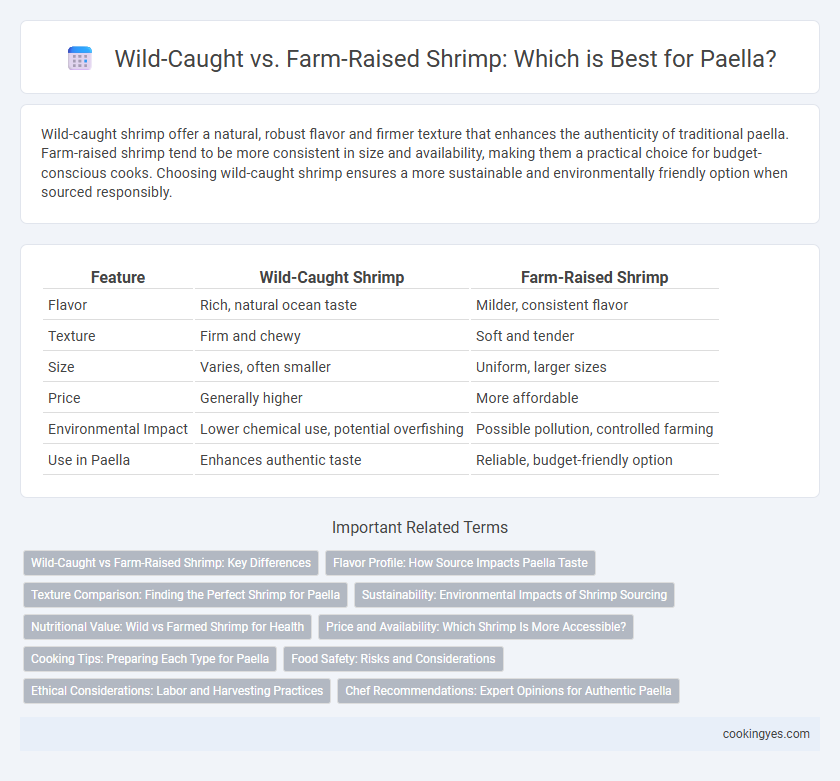Wild-caught shrimp offer a natural, robust flavor and firmer texture that enhances the authenticity of traditional paella. Farm-raised shrimp tend to be more consistent in size and availability, making them a practical choice for budget-conscious cooks. Choosing wild-caught shrimp ensures a more sustainable and environmentally friendly option when sourced responsibly.
Table of Comparison
| Feature | Wild-Caught Shrimp | Farm-Raised Shrimp |
|---|---|---|
| Flavor | Rich, natural ocean taste | Milder, consistent flavor |
| Texture | Firm and chewy | Soft and tender |
| Size | Varies, often smaller | Uniform, larger sizes |
| Price | Generally higher | More affordable |
| Environmental Impact | Lower chemical use, potential overfishing | Possible pollution, controlled farming |
| Use in Paella | Enhances authentic taste | Reliable, budget-friendly option |
Wild-Caught vs Farm-Raised Shrimp: Key Differences
Wild-caught shrimp used in paella offer a distinct, briny flavor and firm texture due to their natural diet and habitat, making them highly prized for authenticity and taste. Farm-raised shrimp provide a more consistent size and availability, often at a lower cost, but may have a milder flavor and softer texture due to controlled feeding and environmental conditions. Choosing wild-caught shrimp enhances the traditional paella experience with superior taste and texture, while farm-raised shrimp provide a practical alternative for affordability and supply stability.
Flavor Profile: How Source Impacts Paella Taste
Wild-caught shrimp offer a briny, ocean-fresh flavor with a firm texture that enhances the authentic taste of traditional paella. Farm-raised shrimp present a milder, slightly sweet profile that may lack the complex, savory depth found in wild varieties. Choosing wild-caught shrimp infuses paella with richer, more robust seafood notes crucial for achieving a true Valencian flavor.
Texture Comparison: Finding the Perfect Shrimp for Paella
Wild-caught shrimp typically offer a firmer, more robust texture ideal for authentic paella, enhancing the dish's overall bite and mouthfeel. Farm-raised shrimp tend to have a softer, sometimes mushier texture that can become overly delicate when cooked in traditional paella methods. Selecting wild-caught shrimp ensures a balanced, satisfying chew that holds up well amidst the rich blend of spices and rice.
Sustainability: Environmental Impacts of Shrimp Sourcing
Wild-caught shrimp often have a lower environmental footprint compared to farm-raised shrimp, as they avoid issues like water pollution, habitat destruction, and antibiotic use commonly associated with aquaculture. However, overfishing and bycatch in wild shrimp harvesting threaten marine biodiversity and disrupt ecosystems. Sustainable sourcing certifications such as Marine Stewardship Council (MSC) help consumers identify shrimp that balance ecological responsibility with preservation of ocean health for paella preparation.
Nutritional Value: Wild vs Farmed Shrimp for Health
Wild-caught shrimp used in paella often have higher levels of omega-3 fatty acids and lower saturated fat content compared to farm-raised shrimp, promoting better heart health. Farm-raised shrimp may contain elevated levels of contaminants and antibiotics due to intensive aquaculture practices, potentially affecting nutritional quality. Choosing wild shrimp enhances the dish's health benefits by providing more natural nutrients and fewer additives.
Price and Availability: Which Shrimp Is More Accessible?
Wild-caught shrimp typically command higher prices due to limited supply and seasonal availability, making them less accessible for frequent purchases in paella recipes. Farm-raised shrimp offer greater availability year-round at a lower cost, providing a budget-friendly option without compromising quantity. Price fluctuations in wild shrimp often lead home cooks to favor farm-raised for consistent accessibility in preparing paella dishes.
Cooking Tips: Preparing Each Type for Paella
Wild-caught shrimp offer a firmer texture and more intense flavor, best enhanced by quick sauteing or adding near the end of paella cooking to prevent overcooking. Farm-raised shrimp, often milder and tender, benefit from gentle simmering with the rice to absorb the dish's rich saffron-infused broth. Properly timing the addition of each type ensures balanced taste and optimal texture in your paella.
Food Safety: Risks and Considerations
Wild-caught shrimp for paella may carry higher risks of contaminants such as heavy metals and pathogens due to their natural environment, making thorough cleaning and proper cooking essential for food safety. Farm-raised shrimp are often monitored for disease and pollutants, but they can contain antibiotic residues and are susceptible to water quality issues, requiring strict farm management and regulation compliance. Consumers should balance potential contaminant exposure with cooking methods, and opt for certified sources to mitigate health risks.
Ethical Considerations: Labor and Harvesting Practices
Wild-caught shrimp for paella often involve rigorous labor conditions with concerns about worker exploitation and unregulated harvesting methods impacting marine ecosystems. Farm-raised shrimp provide more control over labor practices through certification programs, though ethical issues like habitat destruction and chemical use in shrimp farms persist. Choosing shrimp with transparent sourcing and fair labor certifications supports sustainable and ethical seafood consumption for paella.
Chef Recommendations: Expert Opinions for Authentic Paella
Chef recommendations for authentic paella emphasize wild-caught shrimp due to its superior flavor and texture, which enhances the dish's traditional taste profile. Experts highlight that wild-caught shrimp offers a firmer bite and a natural brininess that complements the saffron and smoky notes of paella. Farm-raised shrimp may be more accessible and consistent in quality but often lack the depth of flavor that seasoned chefs prefer for authentic recipes.
Wild-caught vs farm-raised shrimp for paella Infographic

 cookingyes.com
cookingyes.com